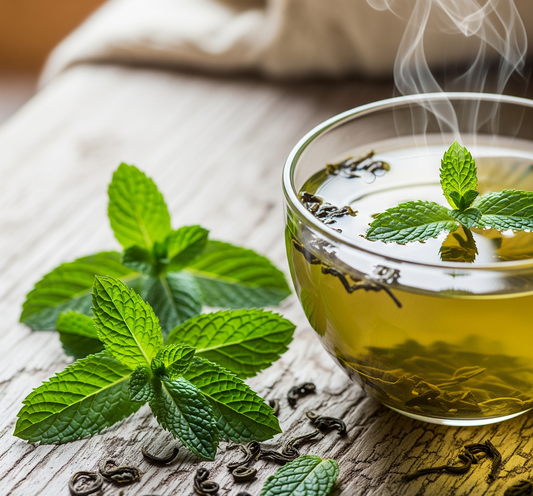Green tea, the second most consumed tea globally, offers a rich variety of flavors and health benefits. This blog explores popular types, including Chinese varieties like Longjing and Japanese options like Sencha and Matcha. Each type has unique characteristics, such as flavor profiles and health advantages, including stress reduction and antioxidant properties. With proper preparation techniques, green tea can be a delightful addition to your daily routine, allowing you to enjoy its diverse tastes and health benefits.
Are you a tea lover looking to explore the fascinating world of green tea? With so many types of green tea available, it can feel overwhelming to know where to start. In this blog, we'll explore the second most consumed tea after black tea, and dive into the diverse varieties of green tea, their unique characteristics, and the benefits they offer.
What are the Different Types of Green Tea?
Green tea comes in a wide range of varieties, each with its own distinct flavor profile and processing method. Here are some of the most popular types of green tea:
-
Chinese Green Teas:
- Longjing (Dragon Well): Known for its flat, sword-shaped leaves and chestnut flavor. According to THE TEA MAKERS of LONDON, this tea may help aid digestion and lower inflammation, helping against arthritis, rheumatism, and other inflammatory problems.
- Bi Luo Chun: Characterized by its tiny, curly leaves and fruity, floral aroma, this tea is known for its antioxidant, anti-inflammatory, and anti-aging properties.
-
Gunpowder: Tightly rolled leaves that resemble gunpowder pellets, with a strong, bold flavor.

- Huangshan Maofeng: Grown in the Yellow Mountains (Huangshan) in Anhui province, this tea has a unique appearance with its straight, pointed leaves and a fresh, delicate flavor.
- Xinyang Maojian: Produced in Henan province, this tea is known for its small, twisted leaves and strong, brisk flavor.
- Lung Ching (Dragon's Well) Bi Luo Chun: From Zhejiang province, famous for its flat, smooth leaves and sweet, nutty flavor.
- Tai Ping Hou Kui: Grown in the Huangshan region of Anhui province, this tea is known for its large, flat, and thin leaves with a mellow and slightly sweet taste.
- Liu An Gua Pian: Grown in Anhui province, this tea is unique because it is made from the leaves, excluding the buds, and has a rich, savory flavor.
-
Japanese Green Teas:
- Sencha: The most common and widely consumed green tea in Japan, made from young tea leaves and buds, steamed and then pan-fried or dried, with a fresh, grassy flavor. According to MATCHA OISHII, the most abundant catechin in this tea is Epigallocatechin Gallate (EGCG), which aids in protecting the cells of the body against oxidation, and heart disease, lowers cholesterol and prevents aging, keeping skin young looking and promoting elastin production.
- Gyokuro: Considered a high-quality green tea, Gyokuro is shaded from the sun for a few weeks before harvesting, resulting in a sweeter, less astringent tea with a rich umami flavor.
-
Matcha: Made from shade-grown tea leaves like Gyokuro, matcha is ground into a fine powder and whisked with hot water, with the whole leaf consumed. It has a distinct, intense flavor and is often used in traditional Japanese tea ceremonies.

Read more on The Magic of Matcha: Exploring Its Health Benefits and Culinary Delights
- Hojicha: Unlike most green teas, Hojicha is roasted after the leaves are steamed, resulting in a reddish-brown color and a nutty, toasty flavor with less caffeine.
- Genmaicha: This tea combines green tea with roasted brown rice, creating a blend with a unique, nutty flavor, sometimes called "popcorn tea" due to the occasional popped rice kernels in the mix.
- Bancha: Made from mature tea leaves and stems, Bancha is harvested later in the growing season than sencha and has a coarser texture and a milder flavor, often considered more robust and less astringent than sencha.
- Kukicha: Also known as twig tea or stem tea, kukicha is made from the stems, stalks, and twigs of the tea plant, with a mild, slightly sweet flavor and a unique aroma.
- Shincha: The first harvest of the year, often associated with high quality and freshness, is essentially a type of sencha prized for its early harvest and vibrant, lively character.
- Tamaryokucha: Also known as "kuradashi" or "guricha," tamaryokucha is pan-fired like Chinese green teas and has a tangy, fruity flavor and a curled leaf shape.
-
Nepalese Green Teas:
- Himalayan Mist: A floral green tea from Nepal, prized for its smoothness and lack of astringency, with deep green, curled leaves.
-
Ganesha Green: Ganesha Green has distinct marine notes, a mellow taste, and an extremely smooth and round mouthfeel, with vibrant, loosely curled leaves.

- Green Pearls: A delicate and mellow organic green tea from Nepal, Green Pearls tea has vegetal notes, a deep green color, and tightly curled leaves.
- Farmer's Green: A reserve tea from Nepal with the fuzzy and light appearance of white tea.
-
Local Pu'er: Many different types of uncategorized steamed green tea cakes can be found across Nepal, often home-grown and hand-crafted, used for medicinal purposes.
Choose from a range of premium organic green teas from Nepal Tea Collective.
The Health Benefits of Organic Green Tea
Tea is a refreshing beverage that contains no sodium, fat, carbonation, or sugar and is virtually calorie-free. The health benefits of organic green tea are backed by extensive research. Some of its most important benefits include:
- Reducing Stress: Green tea contains L-Theanine, a compound that promotes relaxation without causing drowsiness.
- Boosting Metabolism: Drinking green tea can slightly boost metabolism, with up to four cups a day supplementing a healthy lifestyle. According to a research paper in the National Library of Medicine, Consuming tea catechins over an extended period may help combat obesity and type II diabetes caused by a high-fat diet, as well as lower the risk of coronary disease.
- Providing Antioxidants: Organic green tea is an incredible source of antioxidants that remove harmful free radicals and potentially preventing diseases. According to another research in the National Library of Medicine on the Role of Green Tea (Camellia Sinensis) in Anti Photoaging, Stress Resistance, Neuroprotection, and Autophagy, green tea may boost collagen production, offer protection against neurodegenerative diseases, and promote overall health by activating autophagy and lowering oxidative stress in the body.
- Aiding Digestion: Green tea is high in polyphenols that can help prevent gastrointestinal problems.
- Improving Focus: The combination of caffeine-induced alertness and the calming properties of L-Theanine can help maintain a calm focus.
Green Tea Flavor Profile
Green teas are often characterized by clean, grassy, vegetal, marine, or earthy flavor notes. Factors like growing region, plucking season, processing methods, and brewing technique can greatly influence the tea's flavor profile. Choosing the right type of green tea means selecting one that suits your personal taste preferences.
How to Prepare Green Tea

Start with high-quality green tea. The flavor can vary widely based on the type and quality of the tea leaves.
Use about 1 to 2 teaspoons of loose green tea leaves for every 8 ounces (240 ml) of water. Adjust based on your taste preferences.
- Heat the Water
Green tea is sensitive to water temperature. Heat water to around 175–185°F (80–85°C). If you don't have a thermometer, allow the water to cool for a few minutes after boiling.
Pour a small amount of hot water into the teapot or teacup to warm it. Swirl the water around and then discard it. This helps maintain the temperature for steeping.
Place the measured green tea leaves into the preheated teapot or teacup.
Pour the hot water over the tea leaves. Ensure the leaves are fully submerged. For the best extraction, it's advisable to pour the water in a circular motion to evenly wet the leaves.
Green tea requires a shorter steeping time compared to other types of tea. Steep the tea for about 1 to 3 minutes. Steeping time can vary based on the type of green tea, so refer to the specific instructions for your tea.
If you're using loose tea leaves, use a strainer to separate the leaves from the liquid. If you're using tea bags, simply remove the tea bag.
Green tea is often enjoyed without milk or sugar, but you can add honey, lemon, or mint if desired.
Some high-quality green teas can be infused multiple times. Repeat the process, gradually increasing the steeping time with each infusion.
Remember, some high-quality green teas can be infused multiple times, with gradually increasing steeping time for each infusion.
If you're looking for an alternative to green tea, you can also look into hibiscus tea.
Also read: A Guide to Buying and Brewing Hibiscus Tea
Green tea is a versatile and healthy beverage that offers a wide range of flavors and benefits. By exploring the different types of green tea, you can discover new favorites and unlock a world of culinary and health possibilities. Whether you prefer a bold, robust flavor or a delicate, floral aroma, there's a type of green tea out there waiting to be discovered. Happy sipping!




